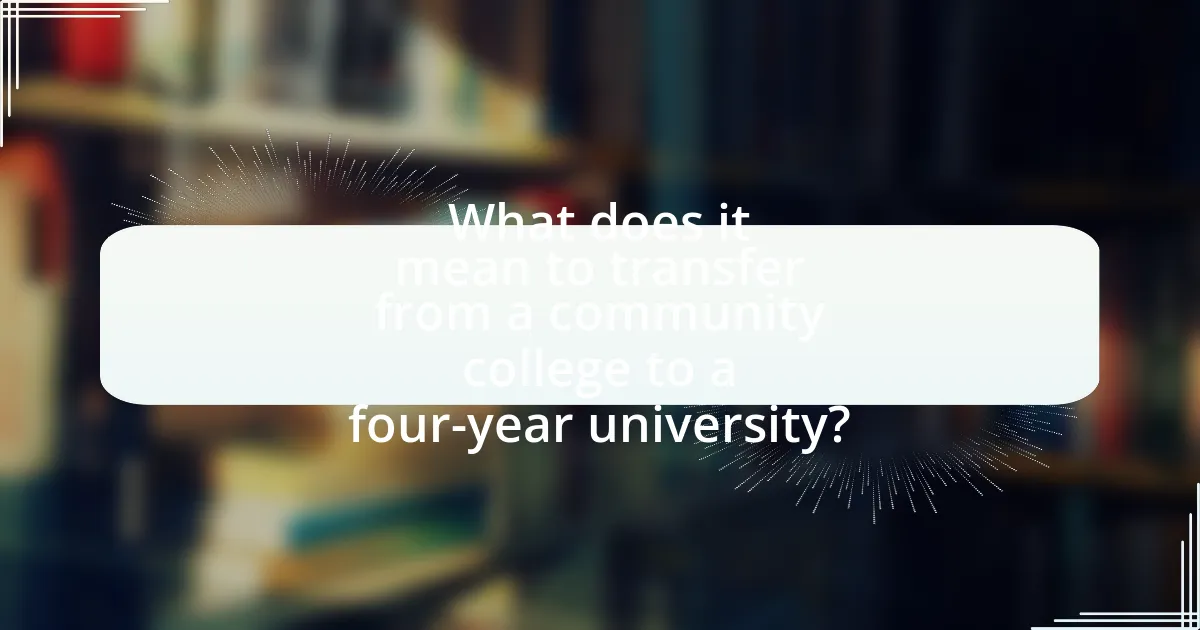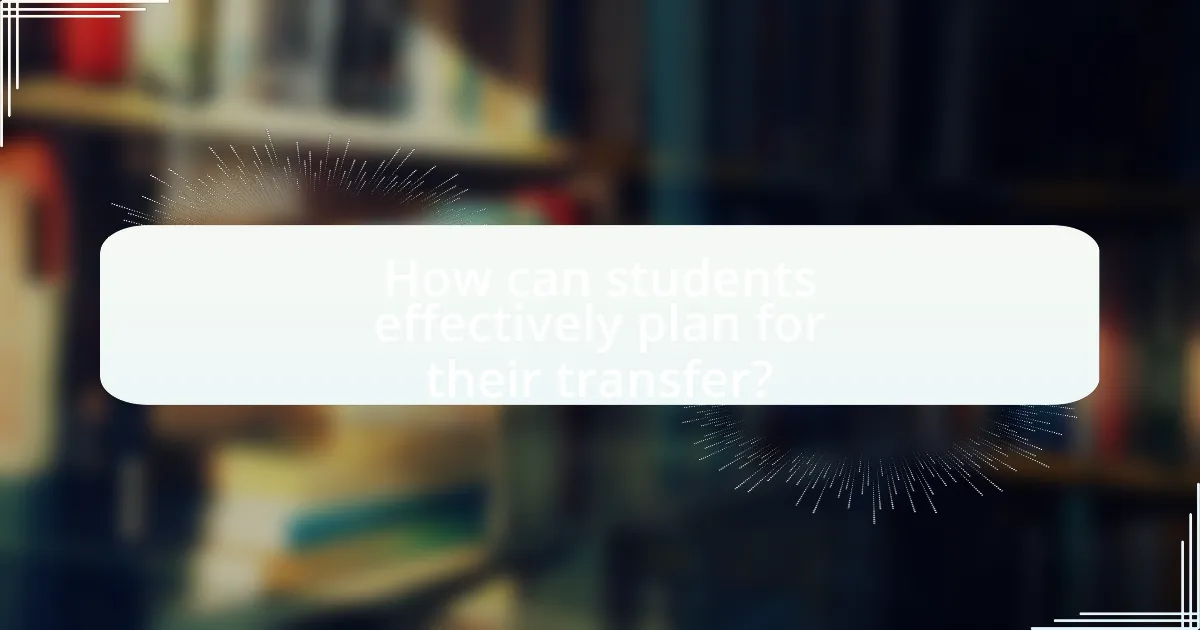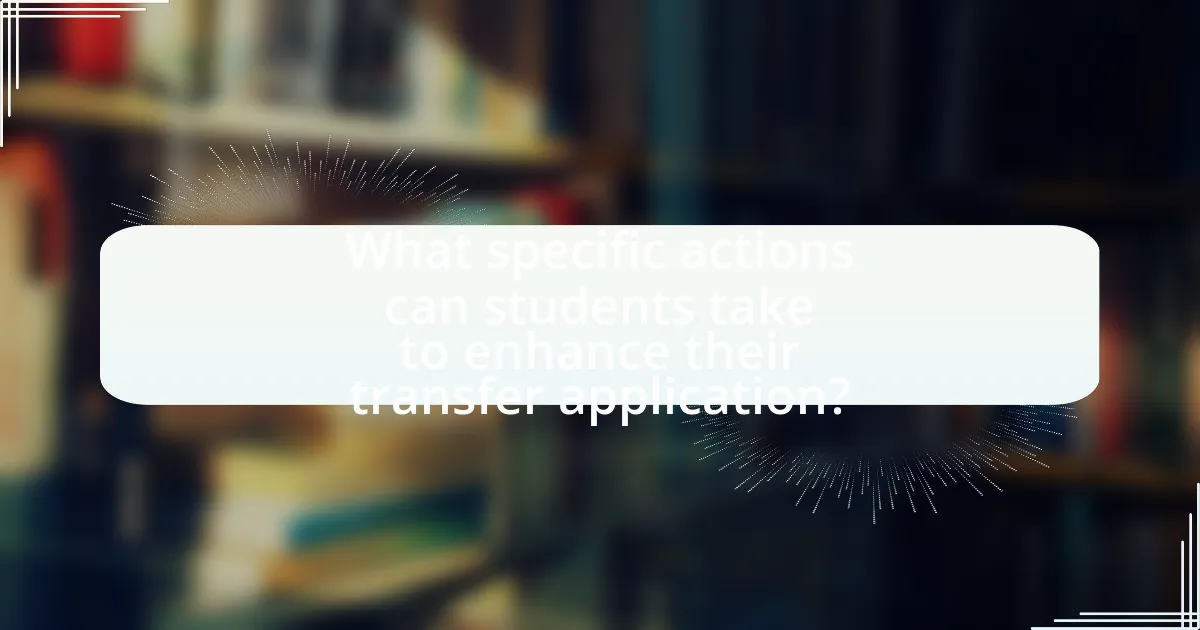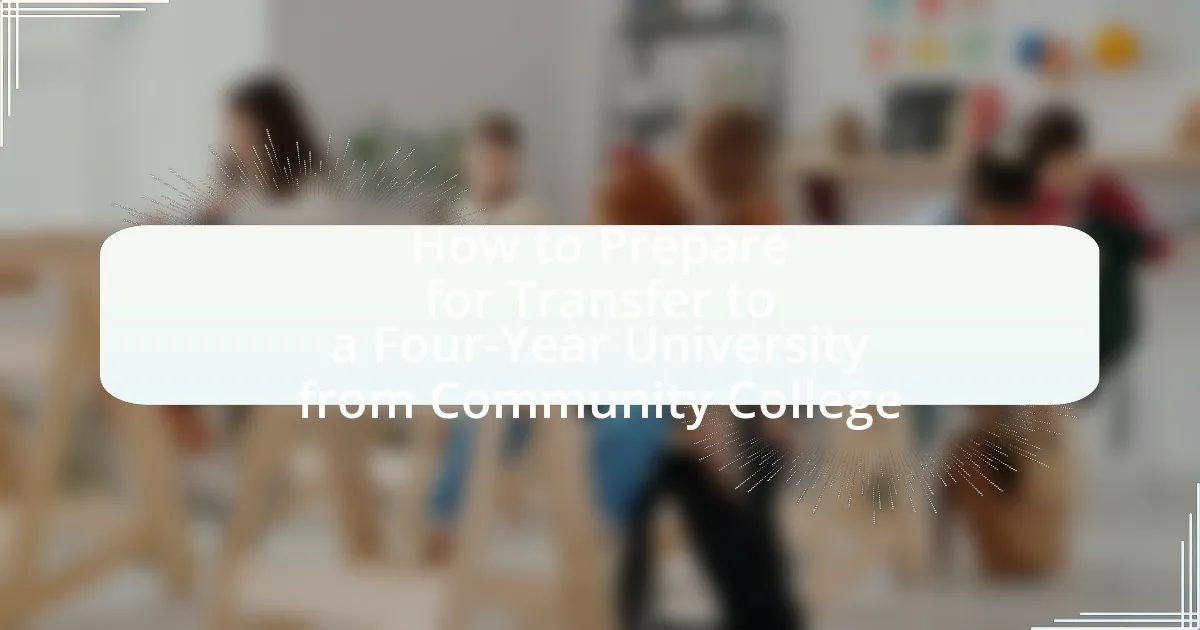Transferring from a community college to a four-year university involves moving from a two-year institution to pursue a bachelor’s degree, typically requiring the completion of an associate degree or transferable credits. This article outlines the motivations for transferring, such as the pursuit of higher earning potential and broader academic opportunities, as well as the challenges students may face during this transition, including credit transfer issues and adjustment to a new academic environment. Key steps in the transfer process, including researching universities, preparing academically, and completing necessary administrative tasks, are discussed, along with strategies for overcoming academic and emotional challenges. Additionally, the article emphasizes the importance of networking, utilizing resources, and adhering to deadlines to enhance the likelihood of a successful transfer.

What does it mean to transfer from a community college to a four-year university?
Transferring from a community college to a four-year university means that a student moves their enrollment from a two-year institution to a four-year institution to pursue a bachelor’s degree. This process typically involves completing an associate degree or a certain number of transferable credits at the community college, meeting the admission requirements of the four-year university, and submitting an application that includes transcripts and possibly letters of recommendation. According to the National Student Clearinghouse Research Center, approximately 30% of students who start at community colleges transfer to four-year institutions within three years, highlighting the commonality and significance of this educational pathway.
Why do students choose to transfer to a four-year university?
Students choose to transfer to a four-year university primarily to obtain a bachelor’s degree, which is often required for higher-paying jobs and career advancement. Research indicates that individuals with a bachelor’s degree earn, on average, 66% more than those with only an associate degree over their lifetime. Additionally, students may seek a broader range of academic programs, extracurricular opportunities, and networking possibilities that four-year institutions typically offer. The National Center for Education Statistics reports that approximately 30% of community college students transfer to a four-year university within three years, highlighting the common goal of pursuing advanced education and improved career prospects.
What are the common motivations for transferring?
Common motivations for transferring from a community college to a four-year university include the pursuit of a bachelor’s degree, the desire for a broader range of academic programs, and the aspiration for enhanced career opportunities. Many students seek to complete their education at a four-year institution to gain access to advanced coursework and specialized fields that may not be available at their current college. Additionally, research indicates that graduates from four-year universities often have higher earning potential and better job prospects compared to those with only an associate degree, reinforcing the motivation to transfer for improved career outcomes.
How does transferring impact a student’s academic journey?
Transferring significantly impacts a student’s academic journey by altering their educational environment, course availability, and social dynamics. When students transfer, they may encounter different academic standards and expectations, which can affect their performance and adaptation. Research indicates that approximately 30% of community college students transfer to a four-year institution, but only about 60% of those complete their degree within six years, highlighting the challenges faced during this transition. Additionally, transferring can lead to the loss of credits, as not all courses may be accepted by the new institution, potentially extending the time needed to graduate. This transition also influences social integration, as students must build new relationships and networks in a different academic setting.
What are the key steps in the transfer process?
The key steps in the transfer process from a community college to a four-year university include researching potential universities, meeting with an academic advisor, completing transfer applications, and ensuring the transfer of credits. Researching universities involves evaluating programs, admission requirements, and campus culture to find the best fit. Meeting with an academic advisor helps students understand transfer policies and course equivalencies, ensuring they take the right classes. Completing transfer applications requires gathering necessary documents, such as transcripts and letters of recommendation, and submitting them by deadlines. Finally, ensuring the transfer of credits involves confirming which courses will be accepted by the four-year institution, often facilitated by articulation agreements between colleges.
How do students prepare academically for the transfer?
Students prepare academically for the transfer by completing required coursework and maintaining a strong GPA. This involves selecting transferable courses that align with the degree requirements of the target four-year university, ensuring that credits will be accepted. Research indicates that students who complete an associate degree before transferring have higher success rates, as they are better prepared academically and have a clearer understanding of their educational goals. Additionally, students often seek academic advising to create a transfer plan that meets both their current institution’s and the prospective institution’s requirements, further enhancing their preparedness for the transition.
What administrative tasks must be completed for a successful transfer?
To ensure a successful transfer from a community college to a four-year university, several administrative tasks must be completed. These tasks include submitting an application for admission to the four-year institution, requesting official transcripts from the community college, and ensuring that all financial aid documents are completed and submitted. Additionally, students must confirm their eligibility for transfer credits by reviewing the transfer credit policies of the prospective university. Completing these tasks is essential, as failure to do so can result in delays or denial of admission.
What challenges might students face during the transfer process?
Students may face several challenges during the transfer process from community college to a four-year university, including credit transfer issues, financial constraints, and adjustment to a new academic environment. Credit transfer issues arise when not all courses taken at the community college are accepted by the four-year institution, potentially delaying graduation. Financial constraints can include higher tuition costs and the need for additional financial aid, which may not be readily available. Additionally, students often struggle with adjusting to a more rigorous academic environment and different social dynamics, which can impact their academic performance and overall well-being. These challenges are well-documented in studies, such as the “Community College Transfer: A Review of the Literature” by the National Student Clearinghouse Research Center, which highlights the complexities students encounter during the transfer process.
How can students overcome academic challenges when transferring?
Students can overcome academic challenges when transferring by actively seeking academic support services and engaging with faculty. Utilizing tutoring centers, academic advising, and study groups can provide essential assistance in adapting to new curricula and expectations. Research indicates that students who participate in academic support programs have higher retention rates and improved academic performance. For instance, a study by the National Center for Education Statistics found that community college students who accessed tutoring services were more likely to succeed in their courses compared to those who did not. Additionally, building relationships with faculty can lead to mentorship opportunities and personalized guidance, further easing the transition.
What emotional or social challenges may arise during the transition?
During the transition from community college to a four-year university, students may face emotional challenges such as anxiety, stress, and feelings of inadequacy. These emotions often stem from the pressure to perform academically in a more competitive environment, as well as the fear of not fitting in socially with new peers. Social challenges can include difficulty in forming new friendships, navigating different social dynamics, and adjusting to a larger campus culture. Research indicates that approximately 30% of students experience significant adjustment issues during this transition, highlighting the importance of support systems and resources to aid in coping with these challenges.

How can students effectively plan for their transfer?
Students can effectively plan for their transfer by researching potential four-year universities and understanding their admission requirements. This involves reviewing the specific courses needed for transfer, ensuring that credits from the community college will be accepted, and maintaining a strong GPA, as many universities have minimum GPA requirements for transfer students. Additionally, students should engage with academic advisors at both their community college and prospective universities to clarify transfer processes and deadlines. According to the National Student Clearinghouse Research Center, students who utilize advising resources are more likely to successfully transfer and complete their degrees.
What resources are available to assist with the transfer process?
Resources available to assist with the transfer process include academic advising services, transfer guides, and articulation agreements. Academic advising services provide personalized guidance on course selection and transfer requirements, ensuring students meet the criteria for their desired four-year institution. Transfer guides outline specific courses and credits that will transfer, helping students plan their community college curriculum effectively. Articulation agreements between community colleges and four-year universities facilitate a smoother transition by detailing which credits are transferable, thus minimizing the risk of losing credits during the transfer. These resources collectively support students in navigating the complexities of transferring to a four-year university.
How can academic advisors help in the transfer planning?
Academic advisors assist in transfer planning by providing personalized guidance on course selection, ensuring that students meet the prerequisites for their desired four-year institutions. They help students understand transfer requirements, including GPA standards and application processes, which are critical for successful transitions. Research indicates that students who engage with academic advisors during their transfer process are more likely to complete their degrees on time and with fewer obstacles, as advisors can offer insights into articulation agreements and transfer credits that maximize students’ previous coursework.
What role do transfer fairs and workshops play in preparation?
Transfer fairs and workshops play a crucial role in preparing students for transferring from community college to a four-year university by providing essential information and networking opportunities. These events allow students to interact directly with representatives from various universities, gaining insights into admission requirements, academic programs, and financial aid options. Research indicates that students who attend transfer fairs are more likely to successfully navigate the transfer process, as they receive tailored guidance and can ask specific questions relevant to their academic goals. Additionally, workshops often cover topics such as application strategies and personal statement writing, equipping students with the skills needed to present themselves effectively to prospective institutions.
How should students select the right four-year university?
Students should select the right four-year university by evaluating factors such as academic programs, campus culture, location, financial aid, and career services. Academic programs should align with students’ intended majors and career goals, ensuring the university offers strong departments in those areas. Campus culture is crucial; students should visit campuses or engage with current students to assess whether the environment fits their personal values and lifestyle. Location impacts daily life and opportunities for internships or jobs, so students should consider proximity to home and urban versus rural settings. Financial aid options, including scholarships and grants, should be thoroughly researched to minimize student debt. Lastly, robust career services can significantly enhance job placement rates after graduation, making it essential to investigate the university’s support in this area.
What factors should be considered when choosing a university?
When choosing a university, factors such as academic programs, location, cost, campus culture, and support services should be considered. Academic programs are crucial as they determine the quality and relevance of education; for instance, universities with strong programs in specific fields often have better faculty and resources. Location affects lifestyle and accessibility; urban universities may offer more internship opportunities, while rural ones might provide a quieter environment. Cost is a significant factor, including tuition, fees, and living expenses, which can impact financial stability and student debt levels. Campus culture influences student life and engagement; universities with diverse student bodies may offer richer experiences. Lastly, support services, such as academic advising and mental health resources, are essential for student success and well-being.
How can students research potential universities effectively?
Students can research potential universities effectively by utilizing a combination of online resources, campus visits, and networking. Online platforms such as university websites, college ranking sites, and forums provide essential information on programs, admission requirements, and student experiences. Campus visits allow students to experience the environment and culture firsthand, while networking with current students and alumni can offer insights into the university’s strengths and weaknesses. According to the National Center for Education Statistics, 85% of students consider campus visits crucial in their decision-making process, highlighting the importance of direct engagement in research.
What are the important deadlines and timelines for transferring?
The important deadlines and timelines for transferring from a community college to a four-year university typically include application deadlines, financial aid deadlines, and enrollment deadlines. Most four-year universities require transfer applications to be submitted by specific dates, often around November 1 for spring admission and April 1 for fall admission. Additionally, financial aid applications, such as the FAFSA, should be completed by the priority deadline, which is usually in early March for the following academic year. Finally, accepted students must confirm their enrollment by a deadline, often set for May 1 for fall admissions. These timelines can vary by institution, so it is essential to check the specific deadlines for each university.
How can students create a timeline for their transfer process?
Students can create a timeline for their transfer process by outlining key milestones and deadlines associated with transferring to a four-year university. First, students should identify their target transfer institutions and research their specific application deadlines, which typically range from six months to a year before the intended transfer date. Next, students should list important tasks such as completing prerequisite courses, gathering recommendation letters, writing personal statements, and preparing for standardized tests, if required.
To ensure a structured approach, students can use a calendar or project management tool to allocate time for each task, setting reminders for deadlines. For example, if a student plans to transfer in the fall, they should aim to complete applications by the previous spring, allowing time for any unforeseen issues. This methodical planning helps students stay organized and meet all necessary requirements, ultimately increasing their chances of a successful transfer.
What are the consequences of missing transfer deadlines?
Missing transfer deadlines can result in the inability to enroll in the desired four-year university for that academic term. This consequence often leads to delays in academic progression, potentially extending the time required to complete a degree. Additionally, students may lose access to financial aid opportunities, as many scholarships and grants have strict deadlines aligned with transfer applications. Furthermore, missing deadlines can limit course availability, forcing students to take less relevant classes or postpone their education altogether. These outcomes underscore the importance of adhering to transfer deadlines to ensure a smooth transition from community college to a four-year institution.

What specific actions can students take to enhance their transfer application?
Students can enhance their transfer application by maintaining a strong GPA, engaging in extracurricular activities, and obtaining strong letters of recommendation. A GPA of 3.0 or higher is often required by many four-year universities, demonstrating academic competence. Participation in relevant clubs or organizations showcases leadership and commitment, which are valued by admissions committees. Additionally, letters of recommendation from professors or employers who can speak to a student’s abilities and character provide credible endorsements that strengthen the application. These actions collectively improve the likelihood of a successful transfer to a four-year university.
How can students improve their academic profile before transferring?
Students can improve their academic profile before transferring by enhancing their GPA, engaging in extracurricular activities, and obtaining strong letters of recommendation. A higher GPA demonstrates academic competence; for instance, maintaining a GPA above 3.0 is often a requirement for transfer applications to competitive universities. Participation in relevant extracurricular activities, such as clubs or volunteer work, showcases leadership and commitment, which are valued by admissions committees. Additionally, securing letters of recommendation from faculty who can attest to a student’s abilities and character can significantly strengthen an application, as personalized endorsements provide insight into the student’s potential for success at a four-year institution.
What types of coursework should students focus on?
Students should focus on coursework that aligns with their intended major at the four-year university. This includes foundational courses in general education, such as English, mathematics, and science, as well as introductory courses specific to their chosen field of study. For example, a student aiming to transfer into a business program should prioritize courses in accounting, economics, and statistics. Research indicates that completing relevant coursework increases the likelihood of successful transfer and degree completion, as it ensures that students meet the prerequisites required by their target institutions.
How important are extracurricular activities in the transfer application?
Extracurricular activities are highly important in the transfer application process. They demonstrate a student’s engagement, leadership skills, and ability to balance academics with other commitments, which are valued by admissions committees. Research indicates that students involved in extracurricular activities often show higher levels of academic performance and personal development, making them more competitive candidates. For instance, a study by the National Association for College Admission Counseling found that 70% of colleges consider extracurricular involvement as a significant factor in admissions decisions.
What documents are typically required for a transfer application?
Typically, a transfer application requires several key documents, including a completed application form, official transcripts from all previously attended institutions, a personal statement or essay, letters of recommendation, and standardized test scores if applicable. These documents provide the admissions committee with a comprehensive view of the applicant’s academic history, personal motivations, and readiness for the new academic environment. Official transcripts are crucial as they reflect the applicant’s previous coursework and grades, while personal statements allow candidates to articulate their reasons for transferring and future goals. Letters of recommendation can further validate the applicant’s capabilities and character, enhancing their overall application.
How should students prepare their transcripts for transfer?
Students should request official transcripts from their current institution to prepare for transfer. This process typically involves contacting the registrar’s office to obtain sealed copies of transcripts, which are often required by the prospective four-year university. Additionally, students should ensure that their transcripts include all completed courses, grades, and credits, as these documents will be evaluated for transferability. It is also advisable for students to review the transfer policies of the target university to understand specific requirements regarding GPA and course equivalencies.
What role do letters of recommendation play in the application process?
Letters of recommendation serve a critical role in the application process by providing insights into an applicant’s character, work ethic, and academic abilities from a third-party perspective. These letters can significantly enhance an application by validating the applicant’s achievements and potential, as they often come from professors, employers, or mentors who can attest to the applicant’s skills and experiences. Research indicates that admissions committees frequently consider these endorsements when making decisions, as they offer a more comprehensive view of the candidate beyond grades and test scores.
What tips can help students succeed in their transfer journey?
To succeed in their transfer journey, students should maintain clear communication with academic advisors at both their current and prospective institutions. This ensures they understand transfer requirements, course equivalencies, and deadlines. Research indicates that students who actively engage with advisors are more likely to complete their transfer successfully, as they receive tailored guidance that aligns with their academic goals. Additionally, students should focus on building a strong academic record, as a GPA of 3.0 or higher is often required for competitive transfer applications. Engaging in extracurricular activities and networking can also enhance their applications, as these experiences demonstrate leadership and commitment.
How can networking with current students and alumni assist in the transfer process?
Networking with current students and alumni can significantly enhance the transfer process by providing firsthand insights and guidance about the target four-year university. Current students can share their experiences regarding the application process, course selection, and campus culture, which can help prospective transfer students make informed decisions. Alumni can offer valuable advice on how to navigate the transition, including tips on securing financial aid and understanding the academic expectations at the new institution. Research indicates that students who engage with peers and alumni are more likely to feel prepared and confident during their transfer, as they gain access to a network of support and resources that can facilitate a smoother transition.
What best practices should students follow when applying to multiple universities?
Students should prioritize organization and research when applying to multiple universities. Maintaining a detailed spreadsheet that tracks application deadlines, requirements, and status for each university helps manage the process efficiently. Additionally, students should tailor their application materials, such as personal statements and resumes, to reflect the specific values and programs of each institution, enhancing their chances of acceptance. Researching each university’s culture, academic offerings, and financial aid options allows students to make informed decisions about where to apply. Following these best practices increases the likelihood of successful admissions outcomes.

Leave a Reply